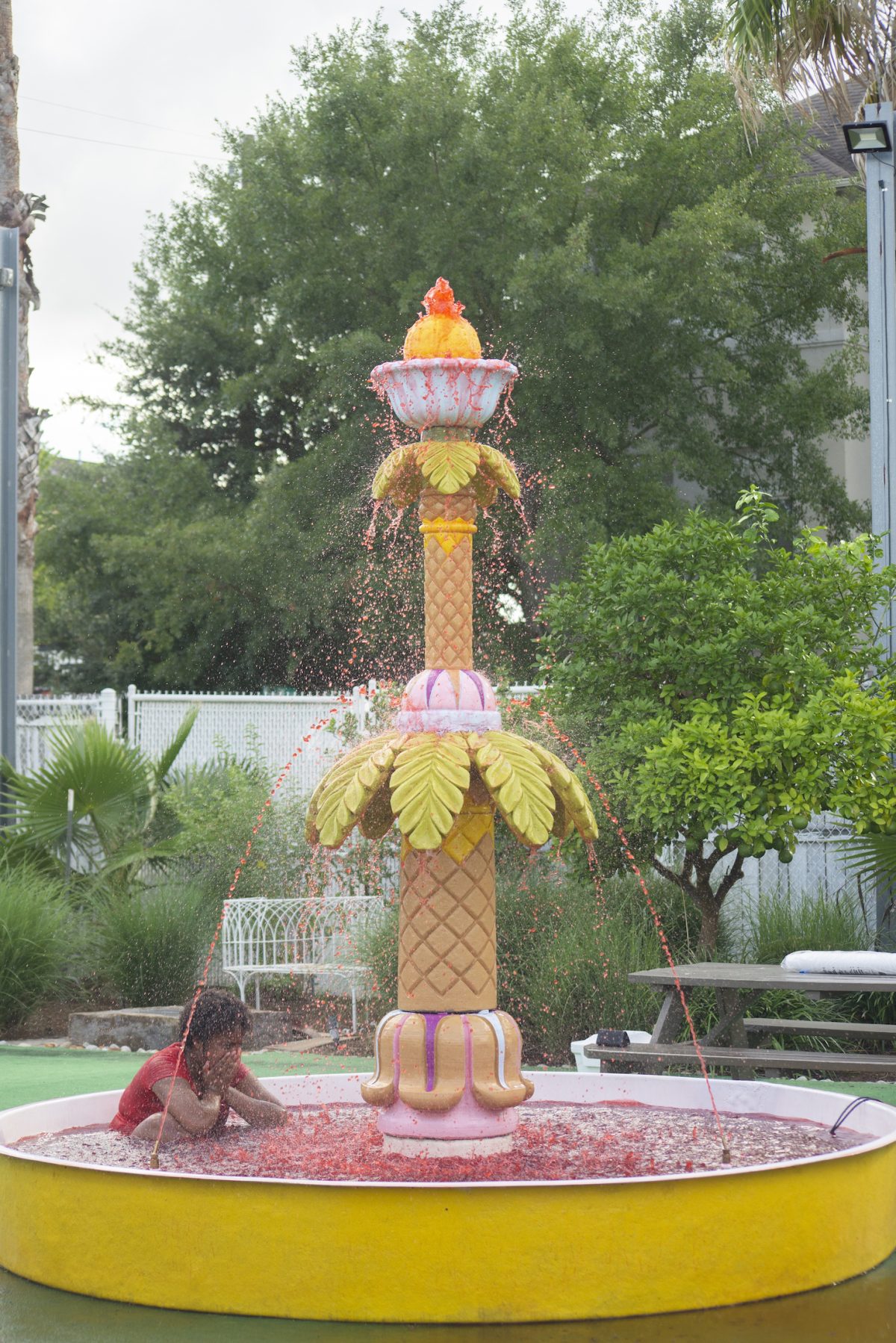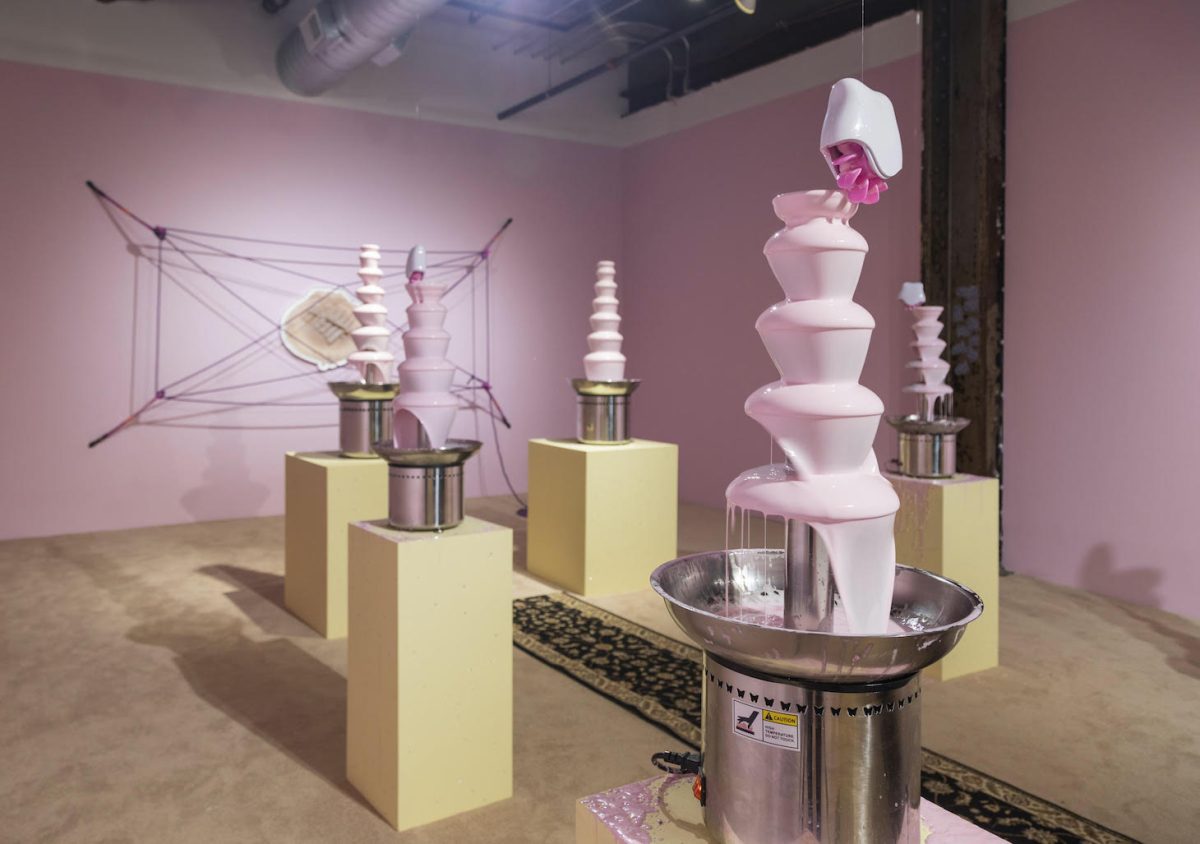by Clarity Haynes
I first saw multidisciplinary artist Pamela Council’s work at the Studio Museum in Harlem in 2015. Council’s sculpture “Flo Jo World Record Nails,” constructed of fake nails, formed an arc that evoked the sensation of taking flight, and paid homage to late track and field athlete Florence Griffith Joyner. I’ve since followed their work, which explores Black joy, grieving, grooming, and memorials in extraordinary ways. I was happy to have the opportunity recently to discuss Council’s work with them via Zoom. For those in Los Angeles, Council will be soon featured in a group show called Sites of Memory, curated by Essence Harden, opening at UTA Artist Space in January of 2021.
***
Hyperallergic: How has the pandemic affected your life as an artist?
Pamela Council: I’d been doing residencies back-to-back, so it was a transient life for me up until May of this year. The pandemic has really been about getting rooted in a home, and a new studio. I’m suddenly taking up a lot of real estate, and I’m grateful for that, because I know a lot of people have had the opposite experience.
H: You’re nesting.
PC: Yes, and looking at work that’s been in storage for the last several years, dealing with my inventory and archive.
H: Has 2020 changed the way you consider your work?
PC: In terms of resources to poor people, access to high-paying jobs and housing, and state violence against Black people, 2020 hasn’t been anything new. The pandemic just exacerbates all of those conditions. But I actually think my work feels more necessary now. At first I was questioning it, because I’m designing a public space for people to come together, and I thought, oh no, pandemic, public space … but now I’m starting to think this is what we need. We need to address issues of monuments, of public gathering, of Black people feeling safe, having fun.
H: You’ve been making what you call “Fountains for Black Joy” for several years, the most recent being the “Red Drink: A BLAXIDERMY Juneteenth Offering” monument (2018).
PC: I don’t think of “Red Drink” as a monument per se, though maybe it is. The word I use is dedication. A monument feels like I’m staking a claim in something, it feels based in property. A dedication is more like a gift. I think this kind of dedication praxis could be a model for new monuments. You know, if you think of roadside altars, in a place where someone’s died, they kind of function that way.

H: They’re meant to be personal and yet they’re public.
PC: And they require community care.
H: Your “BLAXIDERMY Pink” installation was dedicated to your 14-year-old self. That, to me, is a kind of radical vulnerability. Your work is heartfelt and personal while also addressing social, political, and historical issues. Your “Red Drink” fountain has the aesthetics of Willy Wonka and the Chocolate Factory, but you’ve talked about the red soda signifying a blood debt that can never be repaid. And “wtf is juice/GW smile” is a purple fountain made of Grape Drink, silk velvet, party foil, and photographs of George Washington’s dentures, which were made from teeth stolen from animals and enslaved people. There is almost an element of horror there.
PC: Absolutely. People don’t often see that in my work, I think because of the sweet colors I use. There’s a lot of camp in horror, there’s a lot of horror in camp. And there is horror associated with the body. Not just with marginalized bodies — queer bodies, Black bodies, fat bodies — but all bodies. Like the horror of puberty. Traumatic, right? The “wtf is juice” piece is named after a Dave Chappelle joke. I like to think about him as well as rappers like Redman, OddFuture, and Tierra Whack, and the way they use horror and humor. My relationship to object theory and history is more like a comedian than anything else, because they can take something and flip it around and see all sides of it, but they don’t have to tell you that they’ve seen all sides of it. They have a story to tell about it.

H: Maybe that’s what’s so unique about your work. Not just that you use humor, but that you examine something from many sides.
PC: The “Red Drink” fountain ended up being a dedication to my uncle. He died in a horrific way. Because of the size of his body, he was mistreated and we just watched it happen and felt powerless. Within the work I negotiate my family’s grief and the sociopolitical issue of food, combined with this historical Juneteenth story. Imagine if I tried to do that without it being a literally absurd fountain filled with hundreds of gallons of soda? That would be so depressing and pretty much impossible.
H: I watched your 2014 performance “Sweet Grace” at Volta on video. You really held that character, introducing him into the space of the art fair in a procession, with fans being handed out. It was campy, but also serious and real.
PC: Thank you. I wanted to be an apparition in that performance, to embody Sweet Daddy Grace and hold enough stillness to be taken seriously and have people take the fan and learn more about him. He was known as the first charismatic preacher and the first Prosperity Gospel preacher, and I really wanted to be a good steward of that story.

H: Let’s talk about aesthetics.
PC: Thank you. As a Black woman artist, I get asked about the political meaning of my work, but I don’t often get asked why it looks the way it does. I care about the way things look, feel, and smell. I think my aesthetic has childlike exuberance. It’s very Black. I like things that are patterned, that are skillfully and carefully made by hand. I think it’s a Black vernacular camp aesthetic, and I’m dealing with body stuff. I call it BLAXIDERMY — which is a combination of the words “taxidermy” and “blaxploitation.”
H: I’m interested in how you came to formulate your aesthetic philosophy.
PC: I grew up in the Hamptons and was sent to an all-girls boarding school at twelve. Before I left, my mom put me in a metaphysical summer camp. They were doing Kemetic Egyptian religion, teaching me how to do seances and fire ceremonies and stuff. She did this intentionally so that I would have Black cultural references, and I became really curious about incorporating Black mathematics, Black pattern-making, and Black spirituality into my life and work. Then I was at boarding school, at Stuyvesant, at Williams, in the corporate world, at Columbia University. These are not Black spaces. A lot of the work I’ve done in my art and life has been to stay rooted in a Black vernacular aesthetic, a Black pop culture conversation, and to honor my Black American lineage without having to go through academia to do that.

H: Can you say more about how you bypass academia?
PC: I’m not interested in an inaccessible academic conversation that you need critical theory readings to understand. That’s why I say vernacular. I want my work to be understood more immediately. My aesthetic incorporates a sense of the imagination that isn’t too self-serious.
H: How did growing up in the Hamptons influence you?
PC: I think it influenced me a lot. I see the Hamptons as having a front of house and back of house operation, like there’s the theater stage part and then the people doing the work behind it, Disney World type stuff. As a local person in the Hamptons I was aware of how the population shifted from winter to summer, the spaces where my family might not feel comfortable in the summer but we had free reign in the winter, and how you perform differently depending on the season. Which has really radically shaped my sense of audience, whether I’m willing to cater to an audience or not. I make a deliberate choice of who I’m speaking to.
H: You use the word “cater,” which is such a loaded word about power.
PC: Wow, “cater.” Ironically, my mom was a schoolteacher, and in the summer she would do catering jobs at fancy Hamptons parties. That word evidences a particular class relationship that we have to navigate as artists all the time.

H: Catering is the hardest job I’ve ever done, because you have to set up the restaurant, be a waitress, and then break it down again. It’s not easy.
PC: That’s funny, because with my fountains I’m building something temporary that has to be set up, that performs and then gets taken down, which is also the way that Sweet Daddy Grace worked to recruit people. He would do these parades all around the world and the parade would finish in a public baptism in a body of water. That’s how he got people to join his church.
H: Your fountains definitely evoke the idea of baptism. I also think there’s a femme quality to your work.
PC: Yes, there’s a texture, a softness, and that’s where care is important. The lotion sculptures in “BLAXIDERMY Pink” demand a certain kind of care. It’s a demanding femme aesthetic. I’m really interested in my work being high maintenance.
H: So it’s partially about the conditions the artwork creates.
PC: Yes, for me as well as for the audience. Fountains are living objects that people can engage with, not just a static thing in a gallery. Traditionally, they’re public or semi-private works given to a group for merriment, grooming, or nourishment. I love the idea of quenching, that’s hot. Fountains are erected with great intention, and they’re happening for you, the viewer. I like that there’s an on and off switch, it’s all a performance. Things have to be topped off. And when you leave, they’re going to be turned off.
H: What do you hope your work accomplishes in the world?
PC: To me the work is successful when someone says, “You inspired me to go roller skating,” or “I remembered my favorite hobby from when I was a girl and picked it up again.” Or “Your work makes me proud to be a Black person”. Or “Your work reminded me to call my uncle.” I want my work to aid in people’s healing.
